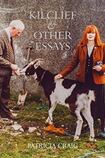
Kilclief & Other Essays is the marvellous harvest-home of a lifetime’s reading and reckoning. At once critic and creator, Patricia Craig is what Jorge Luis Borges calls “a complete reader”; and complete readers, he suggests, are even rarer than good writers.
Why Kilclief? Craig was born and brought up in west Belfast, the Falls Road district. Even after living in London for some years, she says, “I never relinquished Belfast as a sobering and assuaging hinterland”. But then came the Troubles, and Belfast (she quotes the city’s great laureate Ciaran Carson) “tore itself apart and patched things up again”. It had become indeed a thing of shreds and patches. By 1976 her parents “had had enough of fear and loathing . . . They had come to crave tranquillity.”
They moved to Kilclief on the rocky shore of Strangford Lough, and there on their visits from London Craig and her husband, the painter Jeffrey Morgan, “grew to relish the townland’s pure clear air, its ever-changing sea, its birds and butterflies and profuse vegetation, its gorse and montbretia along the roadside, the crooked apple tree in the back garden”. Weaving personal memoir and local history into this quietude, Craig creates an intricate backdrop for the other essays in this collection.
She brings to life a gallery of Irish writers: Patrick Kavanagh, “testy and disgruntled and lyrical”; Brendan Behan undone by “injudicious camaraderie, waywardness, anarchy and buffoonery”; Somerville and Ross whose stories are “full of inoffensive belligerence and loveable improbity”. (How touching that the RM stories continued to be published under both names for years after Ross’s death); then there’s “the mischievous, whimsical, animated manner” of James Stephens, whose The Goat Paths, quoted affectionately here, is one of Irish poetry’s glories: “I would think until I found / Something I can never find,/ Something lying on the ground / In the bottom of my mind”: lines which might provide a motto for those who divine and accumulate as Patricia Craig does.
Sometimes her tone can be edgy, interrogative. Why does JM Synge, whose richly-wrought Irish-English gives his plays an “hypnotic fluency”, write such flat-footed letters? How do the singing lines of Austin Clarke’s early poetry (“O she was the Sunday in every week”) morph into the modernist knottiness of Martha Blake at Fifty? How could a man of Philip Larkin’s illiberal opinions write poetry of such beauty and tenderness: “What will survive of us is love”?
Formidable women writers are among the stars here: Elizabeth Bowen, Edna O’Brien, Helen Waddell. Craig has already published with Penguin Books an authoritative study of Bowen. Here she suggests: “Toughness, melancholy, wit, and a stubborn, oblique romanticism that feeds on loss, are among her characteristics.”
Of O’Brien (who continues to write commandingly into her nineties) Craig observes: “From the start, an astringent and sardonic viewpoint was an invaluable asset which gave an edge to all her utterances. Her characteristic literary manner is clearsighted and disabused.” She salutes O’Brien’s “aesthetic and moral truth” – qualities that might also be ascribed to Helen Waddell (“Ulster’s darling”, someone called her), author of an unexpected best-selling novel Peter Abelard (she “had a talent for communicating the pungency of the past”) and a brilliant translator. Surely Waddell’s distinguished Medieval Latin Lyrics should be back in print.
The range here is phenomenal. An Irish-speaker, Craig gives us a rollicking account of Máirtín O Cadhain’s Cré na Cille (Graveyard Clay) – much underground grumbling. She is tuned in at the deepest level to the Anglo-Irish voice – William Trevor, Hubert Butler. There are engaging essays on children’s literature; on deciphering the hidden meanings of nursery rhymes; on Irish rural furniture; on espionage and photography; on cats and cookery and ghost stories.
She is brave enough to walk into the minefield that is the Irish poetry anthology (volumes edited by Kinsella, Muldoon, Ormsby, and the Field Day team), and she does so without academic obfuscation or special pleading. She proves herself to be John Hewitt’s and Ciaran Carson’s ideal reader, a custodian of Ulster’s troubled psyche.
Rumour has it that in the files there is enough material for a companion volume. I was in Boston in October 2019 when Ciaran Carson died. I felt both relieved and disconsolate when I conjured out of the aether Patricia Craig’s exquisite obituary in the Guardian, a miracle in the way it gave voice to national heartbreak and celebration, as well as to personal grief. Might not this be the soul of a second collection? The townland of Kilclief is inexhaustible.
Michael Longley’s latest collection is The Candlelight Master (Jonathan Cape)
















